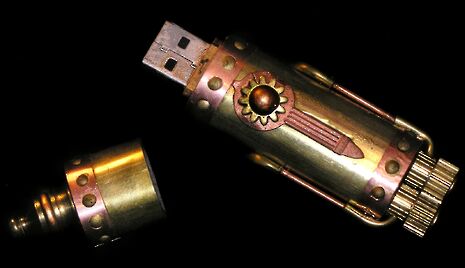Retromania is the mother of invention
Although initially jaded by Instagram’s fetishisation of the past, Hannah Wilkinson explores how retro aesthetics such as Steampunk can use elements of the past to create a future that is almost out of time
"And this is when we went cycling in France..."
I peer over at the iPhone. Courtesy of her favourite app, Instagram, my friend and her boyfriend stare back up at me from behind a yellow filter.
"When did you go, 1967?"
"Last Tuesday."
I knew that. I was being facetious.
Starting life as a humble social networking site in 2010, Instagram has now blossomed into a huge phenomenon, with 100 million users. If Retromania looks at the world through rose-tinted spectacles, Mark Zuckerberg, new owner of the company, just bought the lenses.
I should be exactly the customer they’re looking for, snapping away like it’s 1939. After all, I spent much of my childhood obsessed with the idea of being evacuated to some idyllic village to have twee, vintage adventures, ration book in hand. But now that there’s an app that can make my photos look like that’s what I spent my day doing, suddenly I’m not so keen.
Recent incursions of Retromania into modern life make me deeply uncomfortable. I have grown up to find people actively destroying their own furniture to make it resemble the fittings of a bygone era. But ‘shabby chic’ turns the notion of adversity into a fashion - a worrying sentiment in the middle of a recession, when even those people with the means to buy distressed furniture ought to be concerned with combating adversity, not celebrating it.


Also, unless you’ve been hiding under a distressed chenille throw for the past three years, you’ll have encountered those six little wartime words which now adorn walls, t-shirts, greetings cards and mugs. But commercialising the ‘Keep Calm and Carry On’ spirit both trivialises a period of suffering and glorifies the dangerous notion that Britain is a country that can ‘muddle through’ anything thrown its way.
Retro-obsessed crazes like Instagram seem to hold the past up as perfect. Idyllic. Trouble-free. When all your photos glorify the past, how can you ever move forward?
But my first encounter with Steampunk last month made my change my mind.
It was in the Underbelly in Edinburgh. Suddenly, I was confronted with Tankus the Henge, suited and booted to resemble Victorian gentlemen, top hats and all, steam pouring from a device on the top of the piano and sweat streaming down my face as I danced around to the insane musical lovechild of Madness and The Pogues, via Nineteenth Century London.
Steampunk isn’t just another retro craze glorifying the past. Tankus the Henge may look like they’ve just wandered out of The Old Curiosity Shop, but they use modern instruments, modern devices, to make music which is truly individual and new; it’s the same with the subculture of Steampunk as a whole. Far from being stuck in the past, it fosters invention and creativity, looking back to a time of modernisation and transposing the mechanics of that era onto today’s technology.
The movement started as a way to describe Science Fiction that combined Victoriana with modern technology to imagine an alternative future. A world outside any imaginable time period. Its adherents attempt to live this dream. They actively combine retro materials with 21stcentury technology to create items that look like they’ve come from another dimension. My favourite is the Eye-Pod. An average ipod, except the spinwheel is replaced with a glass eye.
Unfortunately, this insane piece of wonderful other-worldliness is not available in stores, but it isn’t Steampunk’s only contribution to the world. When the design team of Doctor Who wanted to create a character out of time, beyond past and future, they turned to the Steampunk aesthetic. Even Rihanna can’t resist her piece of the subculture. In attempt to create a timeless feel, she rode her pirate ship into the Paralympics closing ceremony in a performance that owed more to Steampunk than it did to Coldplay.

By creating a world out of time, Steampunk challenges the dialectic between old and new: the idea that if you’re not marching forwards, you’re stuck in the past. Rather, it suggests that when you combine the historic with the modern, you can make something new.
Seeing Instagram in the context of ‘Shabby Chic’ and ‘KCACA’ is inadequate. Where photography is often seen as being on a teleological march from blurred to sharp, each new invention moving the discipline from old to new, creating ever clearer, brighter images, Instagram has created something which refuses to participate in this progression. The combination of old-style photography with modern technology has the potential to take photography in a new direction, by asking exactly what people want from their pictures. It has created something neither historic nor modern; something almost out of time. Rather than glorifying retro aesthesis, Instagram uses them to confront the future.
This process of creation can only work with an idea of where we’re coming from, and where we’re going to. Glorifying the past for the sake of old ideas is not necessarily constructive. Re-evaluating those ideas in the context of the modern can be a wonderful way to build the future.
 Interviews / You don’t need to peak at Cambridge, says Robin Harding31 December 2025
Interviews / You don’t need to peak at Cambridge, says Robin Harding31 December 2025 News / Unions protest handling of redundancies at Epidemiology Unit30 December 2025
News / Unions protest handling of redundancies at Epidemiology Unit30 December 2025 Comment / What happened to men at Cambridge?31 December 2025
Comment / What happened to men at Cambridge?31 December 2025 Features / ‘Treated like we’re incompetent’: ents officers on college micromanagement30 December 2025
Features / ‘Treated like we’re incompetent’: ents officers on college micromanagement30 December 2025 Theatre / We should be filming ADC productions31 December 2025
Theatre / We should be filming ADC productions31 December 2025








